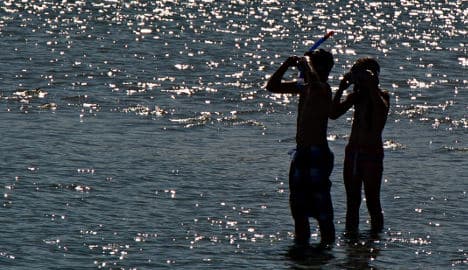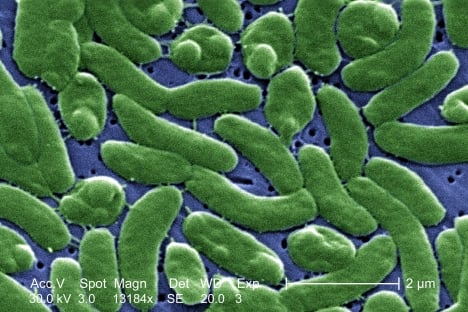Vacationer killed by Baltic Sea bacteria

Six people were infected with a bacteria from the Caribbean which has made itself at home in the popular German vacation destination. One of them is now in a coma.
The bacterium, Vibrio vulnificus, is found in parts of the Baltic Sea and other regions of the world, though most-concentrated in the Gulf of Mexico. It spreads best in brackish waters with temperatures above 20 degrees Celsius.
"This could be found anywhere as long as the conditions are right," Dr. Heiko Will, the first director of State Office of Health and Welfare (LAGuS) of Mecklenburg-Western Pomerania, told The Local. "It is just as prevalent in Denmark, Poland, and all along the German coast."
The victim had been holidaying on the island of Usedom at the end of July, according (LAGuS). He passed away at the beginning of August. Another pensioner has been in a coma for three weeks and there is a possibility he will lose a leg. He went swimming near Ahrenshoop with a small open wound on his leg. He went to the hospital after noticing on the drive home that his leg had turned blue. Doctors diagnosed blood poisoning caused by Vibrio vulnificus.
"My husband would not have been in the Baltic Sea under any circumstances had he known about the danger," his wife, Sonja Bruehl, told the Ostsee Zeitung. "His serious illness and the havoc the sepsis has brought to him and his family could have been avoided with better information, such as a notice from the resort."
LAGuS told dpa news agency that doctors were told to look out for infections at the beginning of the summer, though no public notice was given.
Cooler temperatures have made the already low risk of contracting the bacteria even more nominal.
"The results we have from [Monday's] tests showed a stark decrease in the presence of V. vulnificus," Dr. Will said. "The cooler temperatures have done their job."
Vibrio vulnificus, a relative to the bacteria that causes cholera, is especially harmful to those with chronic liver disease and compromised immune systems, such as those with HIV or diabetes and the elderly. Men are also at a higher risk as oestrogen has shown to have a protective effect against the pathogen. If it takes hold, it causes blood poisoning and sepsis.
Wounds infected by the bacteria have a mortality rate of approximately 25 percent.

The bacteria can also infect people through the ingestion of seafood containing V. vulnificus, though Dr. Will said that is not the case here. "It is mostly in the southern hemisphere where the seafood is also infected."
The last recorded deaths in Germany from V. vulnificus poisoning were in 2010, when the bacteria claimed two victims.
Comments
See Also
The bacterium, Vibrio vulnificus, is found in parts of the Baltic Sea and other regions of the world, though most-concentrated in the Gulf of Mexico. It spreads best in brackish waters with temperatures above 20 degrees Celsius.
"This could be found anywhere as long as the conditions are right," Dr. Heiko Will, the first director of State Office of Health and Welfare (LAGuS) of Mecklenburg-Western Pomerania, told The Local. "It is just as prevalent in Denmark, Poland, and all along the German coast."
The victim had been holidaying on the island of Usedom at the end of July, according (LAGuS). He passed away at the beginning of August. Another pensioner has been in a coma for three weeks and there is a possibility he will lose a leg. He went swimming near Ahrenshoop with a small open wound on his leg. He went to the hospital after noticing on the drive home that his leg had turned blue. Doctors diagnosed blood poisoning caused by Vibrio vulnificus.
"My husband would not have been in the Baltic Sea under any circumstances had he known about the danger," his wife, Sonja Bruehl, told the Ostsee Zeitung. "His serious illness and the havoc the sepsis has brought to him and his family could have been avoided with better information, such as a notice from the resort."
LAGuS told dpa news agency that doctors were told to look out for infections at the beginning of the summer, though no public notice was given.
Cooler temperatures have made the already low risk of contracting the bacteria even more nominal.
"The results we have from [Monday's] tests showed a stark decrease in the presence of V. vulnificus," Dr. Will said. "The cooler temperatures have done their job."
Vibrio vulnificus, a relative to the bacteria that causes cholera, is especially harmful to those with chronic liver disease and compromised immune systems, such as those with HIV or diabetes and the elderly. Men are also at a higher risk as oestrogen has shown to have a protective effect against the pathogen. If it takes hold, it causes blood poisoning and sepsis.
Wounds infected by the bacteria have a mortality rate of approximately 25 percent.

The bacteria can also infect people through the ingestion of seafood containing V. vulnificus, though Dr. Will said that is not the case here. "It is mostly in the southern hemisphere where the seafood is also infected."
The last recorded deaths in Germany from V. vulnificus poisoning were in 2010, when the bacteria claimed two victims.
Join the conversation in our comments section below. Share your own views and experience and if you have a question or suggestion for our journalists then email us at [email protected].
Please keep comments civil, constructive and on topic – and make sure to read our terms of use before getting involved.
Please log in here to leave a comment.